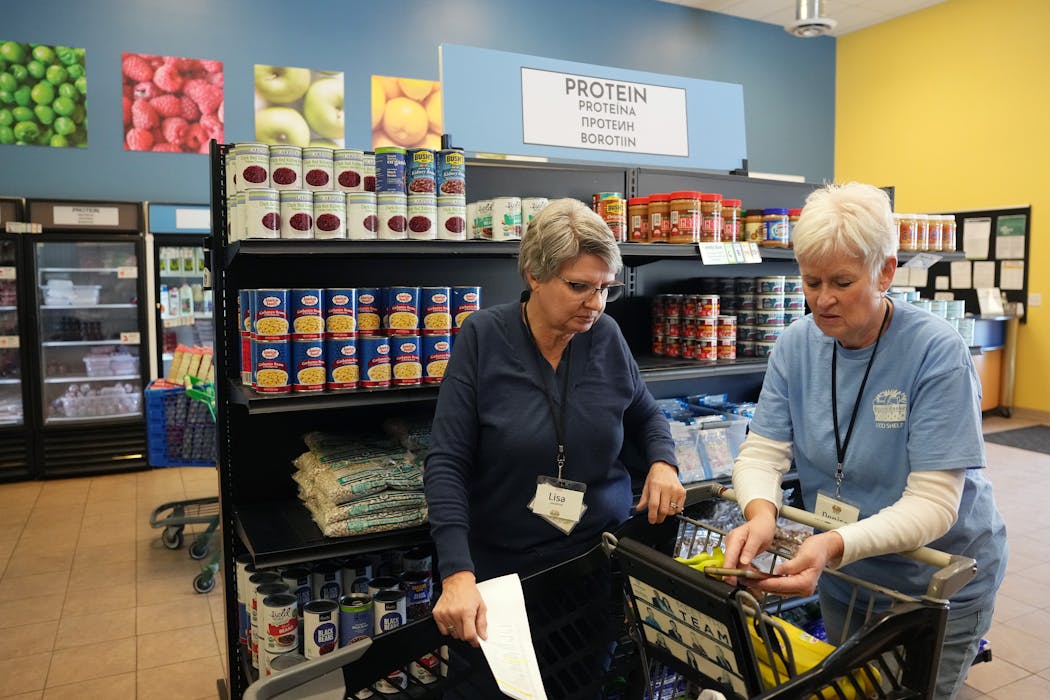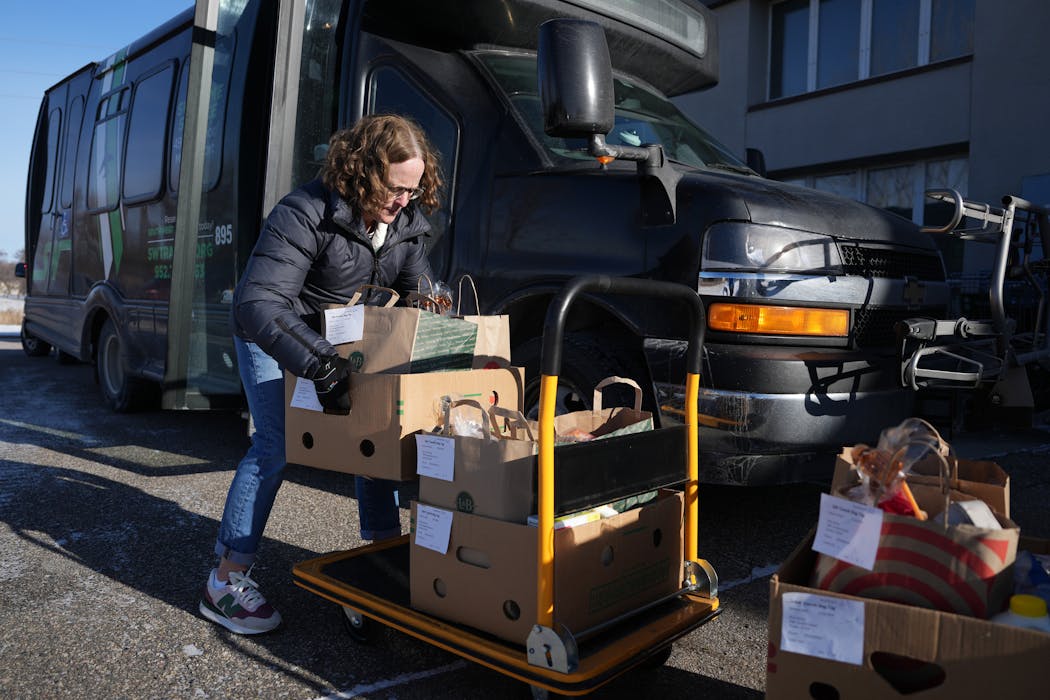A woman arrived at a Chaska food shelf recently, tearful as she sought help for the first time.
"I never thought I'd be in this situation," she told Patti Sinykin, executive director of the Bountiful Basket Food Shelf.
More Minnesotans are finding themselves in dire need. From Brooklyn Center to Bemidji, food shelves saw a record number of visits in 2023 compared to any year in recent history, according to new state data released this week by Hunger Solutions Minnesota.
The state recorded more than 7.5 million food shelf visits, breaking 2022′s record by more than 2 million visits — a more than 30% increase. More Minnesotans also received food stamps in 2023 than any year since 2016, with an average of 447,000 residents a month enrolled in the Supplemental Nutrition Assistance Program (SNAP).
"We know folks are still struggling from the impacts of the pandemic," said Tikki Brown, assistant commissioner of children and family services at the Minnesota Department of Human Services. "Seven million visits is incredibly high ... we want to make sure we can help address that."
A small fraction of the rise in food shelf visits last year could reflect that some food shelves have revised their policies to let people visit more often, getting less food per visit, according to Hunger Solutions, which runs a food helpline. But the number of pounds of food that was distributed in 2023 also rose 10% from 2022. Brown said that SNAP outreach has also improved, so more families who qualify for food stamps are enrolling.
The growing need for food assistance illustrates the uneven economic recovery as many Minnesotans' wages lag behind rising costs, nonprofit leaders say. The state's unemployment rate of 3.1%, as of November is lower than the national rate and average hourly wages are rising, but labor market experts say the cumulative effect over the last three years is that inflation is still surpassing wage growth.
"People who had really dire effects from COVID ... are still experiencing those things. Other people worked from home and put money in their savings accounts. It was such a vast difference in how it affected people," said Colleen Moriarty, executive director of Hunger Solutions. "There are people who literally don't have enough food to know where their next meal will come."
Extra pandemic-related financial aid — from federal stimulus checks to the expanded child tax credit and extra food stamp benefits — bolstered some Minnesotans' budgets since 2020. But that extra relief has ended, and new federal policy changes may be causing more Minnesotans to seek help from food shelves.
Last year, federal work rules for food stamp recipients resumed after a pause during the pandemic. About 27,000 Minnesotans between the ages of 18 and 52 years old without dependents have to meet work rules to consistently be enrolled in SNAP. The age limit was raised last fall from 49 to 52, and that jumps to 54 this October.
That means more Minnesotans will turn to the state's nearly 400 food shelves instead.
"We keep asking [food shelves] to do more," Moriarty said. "They just rise to the occasion."
Both Moriarty and Brown say the influx in food assistance may subside or stabilize this year as more families benefit from Minnesota's free school meals, not needing to turn to food shelves as often. The Legislature approved the measure last year as well as a new state $1,750 child tax credit for nearly 300,000 households, which officials estimate could cut childhood poverty rates by a third.
Nonprofits' budgets strained
In Chaska, Bountiful Basket hasn't seen any dip in demand yet. The nonprofit served more than 5,600 people in 2023, nearly double the number in 2022.
"I've never experienced anything like this before — just the number of people showing up," Sinykin said.
Her nonprofit added a food shelf in Cologne last summer to reach rural areas of Carver County, and appointments immediately booked up. Sinykin said many of the people who show up are nurses, teachers, construction workers — all struggling to make ends meet.
"These are our neighbors. These are working individuals," she said. "And the need is not going away."
In northern Minnesota, Bemidji Community Food Shelf served a record number of residents in 2023, up 25% from 2022. Executive Director Michael Olson said the number of food shelf clients spiked as soon as extra federal benefits faded. The food shelf is still serving people seeking help for the very first time, he added.
"People who were really on the margin ... started showing up," he said. "We're just kind of holding our breath."
It's not just food shelves responding to an influx. In Roseville, Every Meal, which provides 12,000 kids statewide with food on weekends during the school year, is doubling its space by buying the building it has leased, helping it keep up with demand. More kids are participating in their programs, and another 171 schools are on a waitlist to participate in the program.
Nonprofits' budgets are strapped, too, as revenue dwindles and costs rise to purchase food and pay staff. In Chaska, Sinykin said she will have to buy more food to keep her shelves stocked since food drives dwindle after the holidays.
In Brooklyn Center, donations and foundation grants dropped by 30% last year for Community Emergency Assistance Programs (CEAP). President Clare Brumback is projecting a deficit for the first time in three years and leaving positions unfilled. She's also appealing to more food drives; about 30% of the food CEAP provides is purchased from food banks while 70% is free surplus food from grocery stores or donations.
"It's a little more challenging than it has been the last four years," Brumback said. "We really need the community to step up to support us."
New state funding
In December, the state gave $5 million to the state's seven food banks to buy extra food to distribute to food shelves. Last year, the Legislature also approved an extra $3 million a year to food shelves over the next two years and passed, for the first time, a $7 million fund to expand or renovate food shelves.
"We have never invested in our state in facilities in our emergency food shelf system," Brown said. "I think there has been a pent-up need."
During the pandemic, food shelves have gotten more creative in delivering services directly to Minnesotans. In Chaska, Bountiful Basket has expanded outreach to deliver food directly to senior apartments. In Brooklyn Center, Brumback's nonprofit is expanding deliveries this year to more low-income apartments across the northwest metro.
And in South St. Paul, Neighbors Inc. delivers food to low-income and senior apartments, and is distributing more culturally specific food. The nonprofit is serving nearly four times the number of people a year compared to 2019. Food shelf appointments book up immediately.
"We're really exploring everything we can to try to increase the services we can provide, because the need is so great," said Dawn Wambeke, executive director of Neighbors Inc. "It's very clear that people are going hungry. The demand is greater than the resources."

Minneapolis education support workers authorize strike
Officials ID 14-year-old shot and killed while in SUV at northeast Mpls. gas station
Minnesota Republican congressional candidates seek endorsements at Saturday conventions

'No Mow May' eases to 'Less Mow May' in some Twin Cities suburbs




